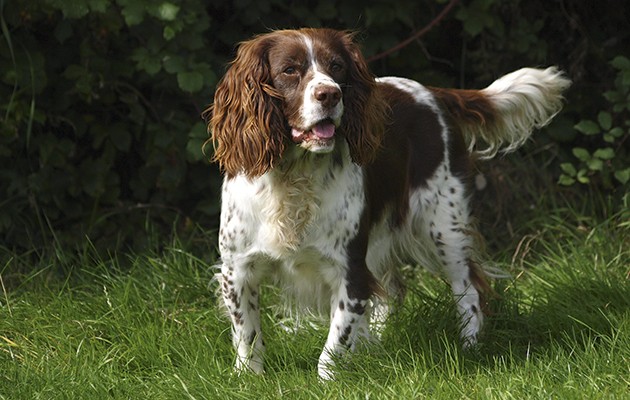Our gundog breeds are endangered through loss of genetic variation. The solution is in our hands. We must change our attitude to breed purity and start outbreeding, says David Tomlinson
Outbreeding could be critical for gundog survival. As accustomed as we are to having springer spaniels, labradors and other such familiar gundogs around, we fail to realise that they are actually endangered. As David Tomlinson says, we must change our attitude to breed purity to save our gundogs.
For more on gundogs, read field trials and tribulations, or all about the wonderful Clumber spaniel: the Bentley of gundogs.
OUTBREEDING
Most of us take animal breeds for granted. There have always been labradors and springer spaniels in our lives, and we assume that there will always be. The truth is that these familiar breeds are seriously endangered, their future genuinely in doubt. Breeds aren’t natural: they have been created by selective breeding that has lessened the animals’ genetic diversity by ensuring that they reproduce true to type. The breeds we are so familiar with today were fixed by breeding father to daughter, even brother to sister.
Today such levels of inbreeding have been outlawed by the Kennel Club (KC), which refuses to register puppies from such close matings, but that doesn’t stop unscrupulous breeders from following such practices. The name on the pedigree may not be the genuine sire. An equally serious problem is the overuse of popular and successful stud dogs, ensuring that a high proportion of dogs in a breed are closely related. Whatever the cause of the inbreeding, the end result is the same: dogs that suffer a high burden of hereditary disease, and this is why outbreeding is so important.
The latest concern about inbreeding has been highlighted in a paper entitled Trends in Genetic Diversity for Kennel Club Registered Breeds, published Canine Genetics & Epidemiology. It provides clear evidence that
no fewer than a quarter of all KC-registered breeds are in trouble; some may not survive. Outbreeding could help them.
THE EPS OF GUNDOG BREEDS: NOT LOOKING GOOD
The conclusions are clear-cut. It looks at the rate of inbreeding in the 200 or so breeds in the UK, establishing what’s called their “effective population size (EPS)”. This is a measure of genetic viability used by conservationists when managing small populations. The higher the EPS the better: some conservationists believe that anything below 500 is of concern.
Go to Breed Population Analyses on the KC’s website. You will find the EPS for all our gundog breeds, and there’s not one that looks good. Take the English springer spaniel, for example. For many years the springer has been in our top three most popular breeds, with well over 10,000 registrations of puppies a year. But according to the KC, “the rate of inbreeding has remained consistently steady and high over the period of the study (1980-2014). This implies genetic variation is being steadily lost from the breed.”
The KC gives the EPS of the springer as 45.1. It warns: “below an effective population size of 100 (inbreeding rate of 0.50% per generation) the loss of genetic variation in a breed/population increases considerably. An effective population of below 50 (inbreeding rate of 1.0% per generation) indicates that the future of the breed may be at risk.”
There’s no chance for labrador enthusiasts to feel smug. The labrador EPS is 81.7 but, the KC notes, “there appears to be an extensive use of popular dogs as sires in this breed”. The EPS for flat-coated retrievers is 67.9; golden retrievers, 61.9; cockers, 49.1; Sussex spaniels, 32.2; English setters, 29.8; clumber spaniels, 24.5.
The paper notes that for most breeds there has been some lessening of the rate of inbreeding in recent years, largely due to the relaxation of quarantine laws allowing fresh blood from overseas. However, there’s the reminder that “while animals imported from overseas may appear completely unrelated, that is not always the case. Often the pedigree available to the Kennel Club is limited in the number of generations, hampering the ability to detect true, albeit distant, relationships.”
Curiously, inbreeding has a variable impact on different breeds. Some with relatively tiny populations seem to be relatively healthy, while others that are much more numerous suffer from many hereditary conditions. The lab comes into the same category, with more than 100 known hereditary diseases, only a few of which are regularly tested for. In contrast, the English springer is relatively healthy, though there is no room for complacency and outbreeding must begin.
CHANGING OUR ATTITUDE TO BREED PURITY
Some years ago, after I’d written an article suggesting that an infusion of new blood into the curly-coated retriever would do wonders for the breed by outbreeding, I received hate mail and was accused of wanting to turn curly-coats into mongrels. For many enthusiasts, retaining the purity of their favoured breed by avoiding outbreeding is far more important than its health.
Many people confuse breeds with species. But while each species is unique, breeds are man-made. Attempting to improve the health of the giant panda by crossing it with a polar bear wouldn’t work, but mixing labrador with flatcoat or springer with cocker by outbreeding does. If our gundogs are to have a future, it’s essential that attitudes to outbreeding not only change but do so soon.





